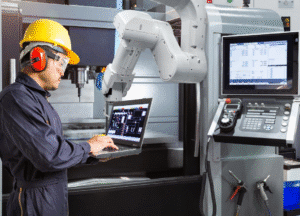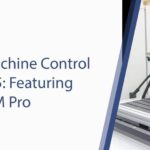The Role and Future of Using Industrial Robots in CNC Machines
CNC (Computer Numerical Control) machines and industrial robots are essential components of modern manufacturing automation. These technologies have revolutionized production processes with their speed, precision, and cost-efficiency. With the influence of Industry 4.0 and digitalization, integrating industrial robots into CNC machines has become more sophisticated and is expected to reach even higher levels in the future. This article delves into the current role of industrial robots in CNC machines and explores future innovations.

The Role of Industrial Robots in CNC Machines
Industrial robots work alongside CNC machines to optimize production processes and offer numerous advantages. This collaboration enhances the efficiency, safety, and flexibility of production lines while continuously evolving to meet modern manufacturing demands. Below, we detail these roles and their application areas.
1. Material Handling and Loading
Robots play a critical role in material handling and loading processes, enhancing the machining capacity of CNC machines. They transport raw materials to the machining tables, remove processed parts, and prepare them for subsequent operations.
Advantages
- Uninterrupted Flow: Robots operate continuously, even during shift changes, accelerating production processes.
- Workplace Safety: Heavy or hazardous materials are handled without human intervention.
- High Efficiency: Tasks are performed faster and more consistently compared to manual handling.
Application Areas
- Automotive Industry: Loading engine blocks and transmission parts onto CNC machines.
- Heavy Industry: Transporting and positioning large cast or pressed components.
Example:
In the automotive sector, robots load raw engine blocks into CNC machines for machining and transport finished parts to assembly lines, minimizing human intervention and significantly reducing production time.
2. Precision and Repeatability
The sub-millimeter repeatability offered by industrial robots complements the precision machining capabilities of CNC machines. This collaboration provides unparalleled advantages in critical industries.
Advantages
- Reduced Error Rates: The high-accuracy movement capabilities of robots minimize machining errors.
- Complex Part Processing: Intricate details that are difficult to achieve manually can be handled with ease.
- Standardized Production: Consistent precision ensures faster quality control processes.
Application Areas
- Medical Sector: Manufacturing prosthetics, implants, or surgical tools.
- Aerospace: Machining turbine blades or precise fastening components.
Example:
An aerospace company uses robots to handle turbine blades during CNC machining, ensuring precise positioning and reducing machining times while improving quality.

3. Multi-Task Management
Robots can interact with multiple CNC machines simultaneously, optimizing production lines and enabling the integration of different process stages.
Advantages
- Time Savings: Robots move parts to another machine as soon as a process is completed.
- Flexible Production Lines: Capable of switching between different types of processes.
- Operational Efficiency: A single robot can manage multiple machines, reducing costs.
Application Areas
- Electronics Manufacturing: Processing PCB boards on CNC machines and transferring them to subsequent assembly stages.
- Machinery Industry: Sequential processing of gears, bearings, and similar components.
Example:
In a factory, robots transfer processed parts from one CNC machine to another while simultaneously performing quality control and assembly tasks.
4. Quality Control
Robots perform quality checks on CNC-machined parts using precision measurement tools and advanced sensors. This enhances product quality while preventing human errors.
Advantages
- Rapid Measurement: Robots quickly scan parts, speeding up quality control processes.
- Error-Free Inspection: Detects flaws invisible to the human eye using sensors.
- Continuous Operation: Quality checks can be performed simultaneously during production.
Application Areas
- Automotive: Dimensional accuracy checks of chassis and engine components.
- Aerospace: Inspecting surface quality and dimensions of critical components like landing gear.
Example:
An aerospace firm uses robots to inspect the surface quality of landing gear components post-CNC machining, eliminating production errors.
5. Specialized Applications
Post-CNC machining processes, such as laser cutting, welding, or assembly, can be completed faster and more efficiently through robotic coordination.
Advantages
- Reduced Processing Time: Immediate transition to subsequent stages after CNC machining.
- More Complex Processes: Enables hybrid production lines.
- Integrated Systems: Acts as a bridge between CNC machines and other equipment.
Application Areas
- Electrical and Electronics: Automatic assembly of CNC-machined parts.
- Defense Industry: Moving parts to laser cutting or surface finishing after CNC machining.
Example:
A defense company reduces production times by 30% by using robots to transfer CNC-machined metal parts for laser cutting.
Future Trends and Innovations
The integration of industrial robots and CNC machines is evolving with technology, paving the way for smarter, more efficient, and sustainable production solutions. Future trends aim to enhance not only production speed but also flexible and customized manufacturing processes. Below are the anticipated innovations in this field:
1. Artificial Intelligence and Autonomy
AI-powered robots will bring smarter capabilities to production lines, including data analysis, decision-making, and learning.
Features and Advantages
- Predictive Maintenance: AI continuously monitors CNC machines and robots, identifying potential faults in advance.
- Autonomous Operations: Robots detect bottlenecks and rearrange processes automatically.
- Self-Learning: Robots analyze production data, becoming more efficient and precise over time.
Example:
A robot detects that a CNC process is taking longer than expected and starts a backup operation on another machine while notifying the operator.
2. IoT and Connected Factories
IoT technologies enable real-time data sharing between CNC machines, robots, and other production equipment.
Features and Advantages
- Real-Time Monitoring: Tracks the status of the entire production line to optimize performance.
- Event-Based Control: Adapts to dynamic changes through equipment interaction.
- Data Analytics: Analyzes data to improve production processes and reduce costs.
Example:
A CNC machine slows its operation due to overheating, and the IoT system informs robots to reduce material handling speed, maintaining synchronization in the production process.
3. Hybrid Production Systems
Future CNC machines and robots will integrate multiple production technologies, creating hybrid systems.
Features and Advantages
- Versatility: Combines multiple manufacturing methods in a single production line.
- More Complex Products: Allows for the creation of intricate designs.
- High Efficiency: Robots transfer and position parts between processes.
Example:
In a hybrid production line, a CNC-machined metal part is immediately transferred to a 3D printer for additional material deposition.
4. Accessibility for SMEs
Lower costs and user-friendly software will make robot technologies more accessible to small and medium-sized enterprises (SMEs).
Features and Advantages
- Cost-Effective Solutions: Smaller, affordable robots cater to SME budgets.
- Ease of Programming: Pre-designed software modules simplify robot programming.
- Flexibility: Easily adapts to low-volume, customized production needs.
Example:
A woodworking shop increases production speed and reduces costs by integrating robots into CNC operations for custom furniture components.
5. Green Manufacturing and Sustainability
Robots enhance energy efficiency in production processes and minimize waste.
Features and Advantages
- Energy Efficiency: Robots operate with optimized, energy-saving movements.
- Waste Management: Collect and sort production waste for recycling.
- Eco-Friendly Production: Reduces resource usage and carbon footprint.
Example:
A manufacturing plant uses robots to collect metal shavings from CNC machines and feed them into recycling processes, saving resources and reducing environmental impact.
Conclusion: The Future of Industry
The integration of CNC machines and industrial robots continues to revolutionize production. Innovations like artificial intelligence, IoT, hybrid production systems, and green manufacturing approaches will make these technologies even smarter and more effective in the future.
These advancements will not only benefit large-scale manufacturing facilities but also offer significant opportunities for small businesses.
With the vision of smart factories and sustainable production, CNC machines and robots will be the cornerstone of the future manufacturing world. These trends will enable the industry to become more efficient, safe, and environmentally friendly.
Contact Us:
- E-Mail: info@radonix.com
- Phone: +90 (553) 920 5500








